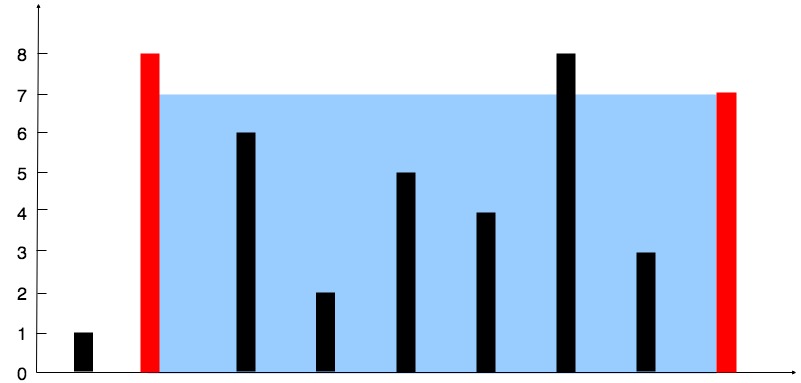Given n non-negative integers a1, a2, ..., an , where each represents a point at coordinate (i, ai). n vertical lines are drawn such that the two endpoints of line i is at (i, ai) and (i, 0). Find two lines, which together with x-axis forms a container, such that the container contains the most water.
Note: You may not slant the container and n is at least 2.
 The above vertical lines are represented by array [1,8,6,2,5,4,8,3,7]. In this case, the max area of water (blue section) the container can contain is 49.
The above vertical lines are represented by array [1,8,6,2,5,4,8,3,7]. In this case, the max area of water (blue section) the container can contain is 49.
Example:
Input: [1,8,6,2,5,4,8,3,7]
Output: 49
Given n non-negative integers a1, a2, ..., an , where each represents a point at coordinate (i, ai). n vertical lines are drawn such that the two endpoints of line i is at (i, ai) and (i, 0). Find two lines, which together with x-axis forms a container, such that the container contains the most water.
Note: You may not slant the container and n is at least 2.

The above vertical lines are represented by array [1,8,6,2,5,4,8,3,7]. In this case, the max area of water (blue section) the container can contain is 49.
Example:
Input: [1,8,6,2,5,4,8,3,7] Output: 49
Javascript Solution to the Container With Most Water of Leetcode
Run the code here: https://repl.it/@VinitKhandelwal/most-water-javascript-leetcode
const maxWater = arr => {
let ans = 0;
for (let i = 0, j = arr.length-1; i < j; i++, j--) {
ans = Math.max(ans, (j-i) * Math.min(arr[i], arr[j]));
if (arr[i] < arr[j]) {
j++;
} else {
i--;
}
}
return ans;
}
Example Input
console.log(maxWater([1,8,6,2,5,4,8,3,7]))
Output
[ 1, 8, 6, 2, 5, 4, 8, 3, 7 ]

Comments
Post a Comment